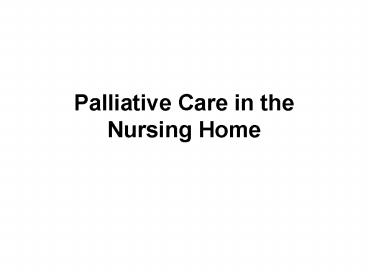Palliative Care in the Nursing Home - PowerPoint PPT Presentation
1 / 26
Title:
Palliative Care in the Nursing Home
Description:
Recognize the need for changes in existing facility ... incorporate the goals of care within the daily practices and operating philosophy of the facility. ... – PowerPoint PPT presentation
Number of Views:311
Avg rating:3.0/5.0
Title: Palliative Care in the Nursing Home
1
Palliative Care in the Nursing Home
2
Objectives
- Develop an awareness of how a palliative care
environment can be created. - Recognize the need for changes in existing
facility policies and procedures to promote the
goals of palliative care. - Become familiar with quality improvement tools
that support excellence in palliative care.
3
Creating a Palliative Care Environment
- Quality of Care Each resident must receive and
the facility must provide the necessary care and
services to attain or maintain the highest
practicable physical, mental, and psychosocial
well-being, in accordance with the comprehensive
assessment and plan of care - F309 Long Term Care Regulations
and Guidance to Surveyors
4
Creating a Palliative Care Environment
- Quality of Care, continued
- Highest practicable level is defined as the
highest level of functioning and well-being
possible, limited only by the individuals
presenting functional status and potential for
improvement or reduced rate of functional
decline. Highest practicable is determined
through the comprehensive assessment by
thoroughly addressing the needs of the
individual.
5
Quality of Life
- A facility must care for its residents in a
manner and in an environment that promotes
maintenance or enhancement of each residents
quality of life. - F240 Long Term Care Regulations and
Guidance to Surveyors
6
Quality of Life
- The intention of this requirement is to
specify the responsibilities toward creating and
sustaining an environment that humanizes and
individualizes each resident.
7
- The facilitys leadership must embrace the
palliative care philosophy and incorporate the
goals of care within the daily practices and
operating philosophy of the facility.
8
Recognize the differences in Goals of Care
- Rehabilitative Goals
- Maintenance Goals
- Preventive Goals
- Palliative Goals
9
Evaluate Current Practices
- Assess staff perceptions of residents needs and
care goals through - Staff Meetings
- Surveys
- Assessment tools
- Review job descriptions/role identification
10
Evaluate Current Practices, continued
- Assess physical plant
- Private areas
- Noise levels
- Phone availability
- Provision of food and beverages between meals
- Review orientation and education regarding end of
life care for all staff. - Review policies/procedures to evaluate how they
reflect/integrate palliative care goals in
delivery of care.
11
CMS suggests surveyors review the following
related to end of life care
- Policies and procedures for providing end of life
care - Palliative care protocols for pain management
- Palliative care protocols for treatment of
distressing symptoms - Care directives to maintain the residents
dignity - Care directives to assisting the
family/significant other in the loss
12
Policies and procedures for review and revision
- MDS/RAI and Goals of Care in Care Planning
- Advance Directives
- Palliative Care Decision Making/ Care Planning
- Pain Management
13
Policies and Procedures continued
- Nutrition and hydration
- Spiritual and Psychosocial Interventions
- Hospice Collaboration
- Imminent Death Interventions
14
MDS/RAI and Goals of Care Planning
- Review existing policies for development of MDS
and Care Plan - Review policy for significant change assessment,
need for ongoing assessment and revisions to
plan of care as condition declines
15
Advance Directives
- Documentation of individual with decision making
authority and when authority becomes effective - Assurance of compliance with advance directives
- Documentation for residents without decision
making ability - CPR policies
16
Palliative Care Decision Making/Care Planning
- Refusals of Care
- Use of skilled therapies or restorative services
- Treatment of wounds
- Use of restraints, bed rails, catheters,
equipment, specialty mattresses - Prevention and intervention for falls
- Role of attending physician and Medical Director
17
Pain Management
- Staff education regarding pain
- Ongoing assessment of pain
- Timeframe for providing pain medications
- Availability of stock pain and emergency
medications - Use of prn medication
18
Pain Management continued
- Resident/family education regarding pain
- Documentation of pain effectiveness and follow-up
- Monthly drug regime reviews
- Utilization of pharmacy consultant
- Use of non-pharmacological approaches
19
Nutrition and Hydration
- Appropriate goals related to diet and weight loss
- Provision of pleasure feedings, availability of
food when desired - Education to staff and family regarding nutrition
goals - Symptom management and tube feedings
- Dehydration issues
20
Spiritual and Psychosocial
- Availability of spiritual support for patient/
family - Communication with significant others and family
- Staff education regarding communication
21
Hospice Collaboration
- Contracts
- Process for referrals and determination of
Hospice appropriateness - Procedures for admission/discharge
- Documentation
- Care Plan
- Hospitalizations and emergency care
22
Hospice collaboration continued
- Medical records management
- Use of therapies
- Respite Care
- Acute inpatient care
- Business office procedures
23
Imminent Death
- Staff education
- Communication and support to family
- Recognition and accommodation of family needs
- Time of death procedure
24
Quality Assurance Monitoring Tools
- MDS Quality Indicator Review
- Medical Record Pain Management Audit
- Hospice Collaboration Tool
- Checklist Review Following an Expected Death
25
- Communication, leadership and accountability
are key. All of these factors in combination can
result in positive resident outcomes
26
(No Transcript)































